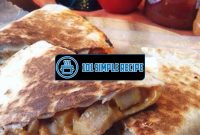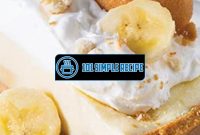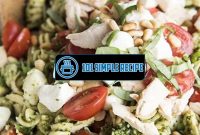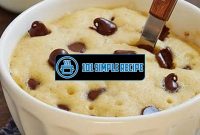If you’re on a gluten-free diet or simply looking for a healthier alternative to regular banana bread, we have the perfect recipe for you. This easy gluten-free banana bread recipe is not only delicious, but it’s also incredibly simple to make. Whether you have a gluten intolerance or just want to try something different, this recipe will become a favorite in your household. With just a few basic ingredients, you can whip up a loaf of moist and flavorful banana bread in no time. Plus, it’s a great way to use up those ripe bananas sitting on your countertop. Get ready to indulge in a scrumptious treat that you’ll love every bite of.
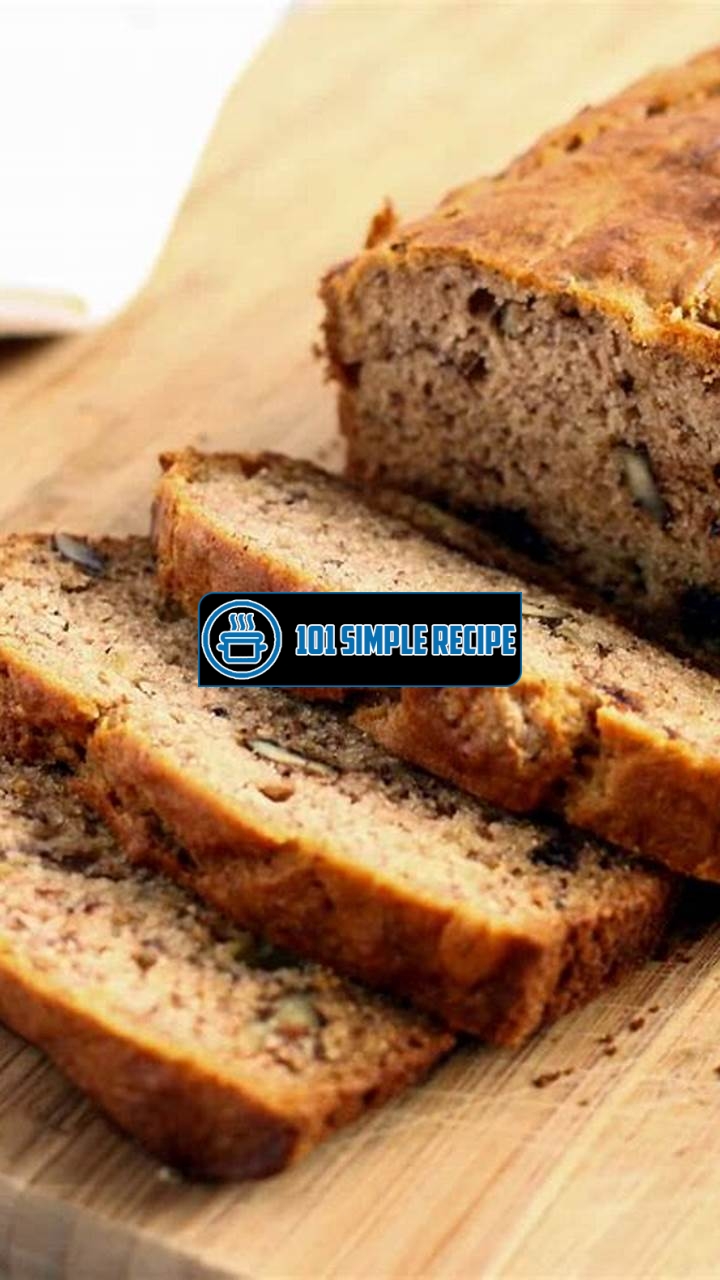
The Rise of Gluten-Free Diets
Gluten-free diets have gained immense popularity in recent years, and it’s no wonder why. With the increasing prevalence of gluten sensitivities and celiac disease, more and more people are opting for a gluten-free lifestyle. But what exactly is gluten, and why are so many individuals choosing to eliminate it from their diets?
Gluten is a protein found in grains like wheat, barley, and rye. It gives dough its elasticity and helps food maintain its shape. However, for individuals with gluten sensitivities or celiac disease, consuming gluten can lead to a range of uncomfortable and sometimes debilitating symptoms.
Gluten sensitivities are more common than you might think. Estimates suggest that around 0.5% to 13% of the global population may be affected.
For those with gluten sensitivities, consuming gluten can result in symptoms like bloating, stomach pain, diarrhea, and fatigue. Celiac disease, on the other hand, is an autoimmune disorder triggered by the consumption of gluten. It causes damage to the small intestine and can lead to long-term health complications if left untreated.
The Need for Gluten-Free Options
The rise of gluten-free diets can be attributed to the growing recognition of these gluten-related health issues.
As awareness about gluten sensitivities and celiac disease has increased, there has been a growing demand for gluten-free options in the food market. Restaurants, food manufacturers, and grocery stores have responded to this need by expanding their gluten-free offerings.
Furthermore, individuals with gluten sensitivities or celiac disease often face significant challenges when dining out or even finding suitable food options at home. A gluten-free diet requires careful attention to ingredient labels, cross-contamination risks, and alternative cooking methods.
Understanding the Gluten-Free Movement
While gluten-free diets are essential for those with gluten-related health issues, they have also gained popularity among individuals without these conditions. This phenomenon, known as the gluten-free movement, has been fueled by numerous factors.
Firstly, some people believe that following a gluten-free diet can lead to weight loss or improve overall health, even if they don’t have gluten sensitivities or celiac disease. However, scientific evidence supporting these claims is limited, and experts generally advise against adopting a gluten-free diet without a medical reason.
Secondly, the influence of social media and celebrities promoting gluten-free lifestyles has played a significant role in popularizing this dietary trend. People often emulate their favorite influencers and are swayed by endorsements from public figures, unaware of the potential consequences of unnecessarily eliminating gluten from their diets.
Benefits of a Gluten-Free Diet
For individuals with gluten sensitivities or celiac disease, following a gluten-free diet is essential for managing their condition and preventing complications. By eliminating gluten, they can reduce uncomfortable symptoms and improve their overall quality of life.
It’s important to note that a gluten-free diet should be followed under the guidance of a healthcare professional or a registered dietitian.
While a gluten-free diet may not offer additional health benefits for those without gluten sensitivities or celiac disease, it can still be a healthy lifestyle choice if approached conscientiously. It encourages individuals to focus on whole, unprocessed foods such as fruits, vegetables, lean proteins, and gluten-free grains like rice or quinoa.
In conclusion, the rise of gluten-free diets can be attributed to the increasing prevalence of gluten sensitivities and celiac disease, along with the need for gluten-free options in the food market. However, it’s crucial to understand that a gluten-free diet should only be adopted if medically necessary. Consulting with a healthcare professional or a registered dietitian is essential before making any dietary changes.
You can find a simple recipe for gluten-free banana bread on our website. Check it out here!
Why Choose Gluten-Free Banana Bread?
Discover the reasons why gluten-free banana bread is an excellent option for individuals looking to enjoy a delicious and healthier alternative to traditional banana bread recipes.
Nutritional Benefits of Gluten-Free Banana Bread
Gluten-free banana bread offers a range of nutritional benefits that make it a fantastic choice for health-conscious individuals. Firstly, bananas themselves are packed with essential nutrients. They are a great source of potassium, vitamin C, and dietary fiber. These nutrients are important for maintaining a healthy heart, boosting the immune system, and promoting regular digestion.
By choosing a gluten-free version of banana bread, you are eliminating wheat flour, which contains gluten. Gluten is a protein that can trigger negative reactions in individuals with gluten intolerance or celiac disease. Going gluten-free can alleviate symptoms such as bloating, fatigue, and digestive issues.
Another benefit of gluten-free banana bread is that it is often made with alternative flours such as almond flour or coconut flour. These flours are not only gluten-free but also higher in protein, fiber, and healthy fats compared to traditional wheat flour. This boosts the nutritional profile of the bread and provides a more well-rounded snack or breakfast option.
Overall, choosing gluten-free banana bread ensures that you are getting a nutritious treat that supports your overall well-being.
Availability and Accessibility of Ingredients
One of the advantages of making gluten-free banana bread is the availability and accessibility of the ingredients needed. Gluten-free flours and other substitutes can often be found in most grocery stores or health food stores. With the growing popularity of gluten-free diets, these ingredients are becoming increasingly mainstream and easier to find.
Additionally, many gluten-free banana bread recipes require simple and accessible ingredients that you may already have in your pantry. The main ingredients typically include ripe bananas, gluten-free flour, eggs, baking powder, and a natural sweetener such as honey or maple syrup. These ingredients are easy to obtain, and you don’t have to embark on a special shopping trip to find them.
When you choose gluten-free banana bread, you don’t have to compromise on taste or convenience. The ingredients are readily available, allowing you to whip up a delicious batch of gluten-free banana bread whenever the craving strikes.
Avoiding Cross-Contamination
For individuals with gluten intolerance or celiac disease, cross-contamination can be a significant concern. Even small traces of gluten can trigger uncomfortable symptoms and health issues. By opting for gluten-free banana bread, you can ensure that your baked goods are safe from cross-contamination.
When you make your own gluten-free banana bread at home, you have complete control over the ingredients and preparation process. You can ensure that all utensils, surfaces, and equipment are thoroughly cleaned and free from any traces of gluten. This reduces the risk of cross-contamination and allows you to enjoy your banana bread without worrying about the negative effects of gluten.
Similarly, if you purchase gluten-free banana bread from a reputable bakery or store, you can trust that they have taken the necessary precautions to avoid cross-contamination. Many gluten-free products come with clear labeling and certifications, providing peace of mind for individuals with dietary restrictions.
By choosing gluten-free banana bread, you can enjoy a tasty treat while minimizing the risk of consuming gluten and its associated complications.
If you’re looking for other gluten-free recipes, we also have a great weight loss recipe you might enjoy.
Simple Steps to Gluten-Free Banana Bread
Creating a mouthwatering gluten-free banana bread that is easy to make and suitable for individuals with gluten sensitivities or celiac disease is simpler than you may think. Follow these simple steps to whip up a delicious loaf of gluten-free banana bread.
- Gather the Ingredients: Collect all the necessary ingredients for your gluten-free banana bread. You will need ripe bananas, gluten-free flour, baking powder, baking soda, salt, sugar, eggs, vegetable oil, and vanilla extract.
- Mash the Bananas: Start by peeling the ripe bananas and placing them in a bowl. Use a fork or potato masher to mash them until they reach a smooth consistency. The bananas will add natural sweetness and moisture to your bread.
- Combine the Dry Ingredients: In a separate bowl, mix the gluten-free flour, baking powder, baking soda, and salt. Ensure that all these dry ingredients are well combined before moving on to the next step.
- Prepare the Wet Ingredients: In a large mixing bowl, beat the eggs until frothy. Then, add the sugar, vegetable oil, and vanilla extract. Mix well until all the ingredients are thoroughly incorporated.
- Blend the Dry and Wet Ingredients: Gradually add the dry ingredient mixture to the wet ingredients, stirring continuously. Ensure that there are no lumps and the batter becomes smooth.
- Add the Mashed Bananas: Fold in the mashed bananas into the batter. The banana mixture will add a natural sweetness and moisture to the bread.
- Grease the Pan: Grease a loaf pan with cooking spray or vegetable oil to prevent the bread from sticking to the sides. You can also line the pan with parchment paper for easier removal.
- Bake the Bread: Pour the batter into the greased loaf pan and spread it evenly. Preheat your oven to 350°F (175°C) and bake the bread for about 55-60 minutes or until a toothpick inserted into the center comes out clean.
Finding the Perfect Gluten-Free Flour
Finding the right gluten-free flour is crucial for achieving the perfect texture and taste in your banana bread. There are various options available, such as almond flour, rice flour, tapioca flour, or a gluten-free flour blend.
Almond Flour: Almond flour adds a nutty flavor and a moist texture to your bread. It’s a popular choice for gluten-free baking.
Rice Flour: Rice flour is another common gluten-free alternative that provides a light and tender crumb to your banana bread.
Tapioca Flour: Tapioca flour is often used in combination with other gluten-free flours to improve the texture and create a softer bread.
Gluten-Free Flour Blend: Using a pre-made gluten-free flour blend can save you time and ensure a balanced mix of flours for optimal results. Look for blends that are specifically designed for baking.
Enhancing Flavor and Texture
Boost the flavor and texture of your gluten-free banana bread by incorporating these additional ingredients:
- Cinnamon: Add a teaspoon or two of cinnamon to enhance the warm and comforting flavors of your banana bread.
- Nuts and Seeds: Chopped walnuts, pecans, or sunflower seeds can provide a delightful crunch and add extra nutrients to your bread.
- Dried Fruits: Consider adding dried fruits like raisins or cranberries for a burst of sweetness and a chewy texture.
- Chocolate Chips: For the chocolate lovers, fold in a handful of gluten-free chocolate chips for a decadent twist.
Baking and Storing Tips
Once your gluten-free banana bread is baked to perfection, follow these tips to ensure it stays fresh and delicious:
Allow to Cool: Let the bread cool in the pan for about 15 minutes before transferring it to a wire rack to cool completely. This helps prevent it from crumbling or breaking apart.
Store Properly: Keep your gluten-free banana bread in an airtight container or wrapped tightly in plastic wrap to maintain its moisture.
Refrigerate or Freeze: If you have leftovers or want to prolong its shelf life, you can store the bread in the refrigerator for up to a week or in the freezer for up to three months.
Now that you have mastered the process of making mouthwatering gluten-free banana bread, enjoy every flavorful slice without worrying about gluten sensitivities or celiac disease. Happy baking!
Want to try something fun and refreshing? Check out our punch bowl recipe for a delicious drink!
Exploring Variations of Gluten-Free Banana Bread
Discover exciting variations of gluten-free banana bread that add unique flavors and ingredients to create a personalized twist on this classic recipe.
Adding Nuts and Seeds for Texture and Crunch
Take your gluten-free banana bread to the next level by adding nuts and seeds. Not only do they provide a delicious crunch, but they also add texture and enhance the overall flavor. Here are some ideas to consider:
- Walnuts: These are a classic choice and provide a rich, earthy flavor. Chop them up and fold them into the batter for an extra kick.
- Pecans: If you prefer a milder nut flavor, pecans are a great option. They add a subtle sweetness and a buttery texture.
- Chia Seeds: Boost the nutritional value of your gluten-free banana bread by incorporating chia seeds. They’re packed with omega-3 fatty acids, fiber, and antioxidants.
- Sunflower Seeds: For a nut-free alternative, try sunflower seeds. They add a delightful crunch and pair well with the sweetness of the bananas.
- Pumpkin Seeds: Another nut-free option, pumpkin seeds are loaded with vitamins, minerals, and antioxidants. They add a unique twist and a bit of chewiness.
Experimenting with Gluten-Free Flours and Starches
When it comes to gluten-free banana bread, there are numerous flour and starch options available. Experimenting with different combinations can result in a wonderfully moist and flavorful loaf. Consider trying the following:
- Almond Flour: Almond flour adds a subtly sweet and nutty flavor to your banana bread. It’s also high in protein and healthy fats.
- Coconut Flour: This gluten-free flour option provides a unique tropical taste and a dense texture. It’s highly absorbent, so be sure to adjust the liquid ingredients accordingly.
- Oat Flour: Made from ground oats, oat flour has a slightly nutty taste and adds a soft crumb to your banana bread. Look for certified gluten-free oat flour if you have celiac disease or a severe gluten intolerance.
- Cassava Flour: Derived from the yuca root, cassava flour is a versatile gluten-free alternative. It has a neutral taste and can be used as a 1:1 replacement for wheat flour in many recipes.
- Tapioca Starch: Tapioca starch adds a lightness and chewiness to your gluten-free banana bread. It’s often used in combination with other flours to improve texture.
Incorporating Chocolate and Other Indulgent Additions
If you’re looking to satisfy your sweet tooth, consider incorporating some indulgent additions into your gluten-free banana bread. These additions can elevate the flavor and make your loaf even more irresistible. Here are a few ideas:
- Dark Chocolate Chips: Intensify the richness of your banana bread by adding dark chocolate chips. They melt into gooey pockets of goodness, resulting in a decadent treat.
- Cocoa Powder: For a double dose of chocolate, add cocoa powder to your batter. It deepens the flavor and gives your bread a rich, dark color.
- Dried Fruits: Experiment with dried fruits like raisins, cranberries, or chopped dates. These add a burst of sweetness and a delightful chewiness to every bite.
- Coconut Flakes: Toasted coconut flakes bring a tropical twist to your gluten-free banana bread. They add a lovely crunch and a subtle coconut flavor.
- Caramel Swirl: Drizzle a homemade caramel sauce on top of your banana bread batter before baking. It creates a luscious swirl throughout the loaf.
In conclusion, gluten-free banana bread can be easily customized to suit your taste preferences and dietary needs. Whether you choose to add nuts, experiment with different flours, or indulge in chocolate, each variation brings something unique to this classic recipe. Get creative and enjoy the process of making your very own gluten-free banana bread masterpiece!
Gluten-Free Banana Bread for Every Occasion
Are you a fan of banana bread? If so, you’ll be delighted to discover that there is a gluten-free version that is just as delicious and easy to make. Gluten-free banana bread is the perfect treat for any occasion, whether it’s a lazy weekend brunch, a special celebration, or a quick snack. In this article, we will explore different ways to serve and enjoy gluten-free banana bread, from breakfast options to delectable dessert pairings that will satisfy your cravings.
Delicious Breakfast or Brunch Ideas
Starting your day with a slice of warm gluten-free banana bread can be a real treat. It’s a hearty and wholesome option that will keep you satisfied until lunchtime. You can enjoy it on its own or get creative with toppings and spreads. Here are some delicious breakfast or brunch ideas to try:
- Add a dollop of creamy almond butter and a sprinkle of crunchy granola for a delightful combination of flavors and textures. ️
- Pair it with some Greek yogurt and fresh berries for a refreshing and nutritious meal.
- For a more indulgent option, serve it with a smear of Nutella and a sprinkle of chopped hazelnuts.
- If you’re feeling adventurous, try grilling a slice of banana bread and serve it with a side of crispy bacon. The sweet and savory combination is simply heavenly.
Stunning Presentation for Special Occasions
When you’re hosting a special occasion or want to impress your guests, presenting your gluten-free banana bread in an eye-catching way can make all the difference. Here are some tips to make your gluten-free banana bread shine on the table:
- Slice the bread and arrange it on a beautiful wooden serving board for a rustic and charming presentation.
- Dust the top of the bread with powdered sugar and garnish with fresh mint leaves for an elegant touch.
- Transform your banana bread into cute individual servings by baking them in mini loaf pans or muffin tins. Arrange them on a tiered dessert stand for a lovely display.
- Drizzle a homemade caramel sauce over the bread right before serving. The sticky sweetness will take your banana bread to the next level.
Serving Suggestions for Dessert or Snack Time
Of course, gluten-free banana bread is not just for breakfast or special occasions. It also makes for a delightful dessert or snack option. Here are some serving suggestions to enjoy your banana bread at any time:
- Toast a slice of banana bread and top it with a scoop of vanilla ice cream. The warm and cold combination is irresistible.
- Create a decadent banana bread trifle by layering cubes of banana bread, whipped cream, and sliced bananas in a glass. Repeat the layers and finish with a dollop of whipped cream on top.
- Spread a layer of cream cheese frosting on your banana bread for a rich and creamy treat.
- Make banana bread French toast by dipping slices of bread in a mixture of beaten eggs, milk, and cinnamon. Cook them on a griddle until golden brown and serve with a drizzle of maple syrup.
As you can see, there are endless possibilities when it comes to serving and enjoying gluten-free banana bread. Whether you prefer it for breakfast, dessert, or snack time, this delicious treat will surely satisfy your cravings. Give it a try and let your taste buds rejoice!
Frequently Asked Questions
Thank you for reading our article on gluten free banana bread recipe easy! Here are some frequently asked questions that might help you:
| No. | Questions | Answers |
|---|---|---|
| 1. | Can I use almond flour instead of regular flour in this recipe? | Yes, you can substitute almond flour for regular flour in this recipe. However, please note that the texture and taste may be slightly different. |
| 2. | Can I use honey instead of maple syrup? | Yes, you can use honey as a substitute for maple syrup. Just keep in mind that honey has a stronger flavor, so it may alter the taste of the banana bread slightly. |
| 3. | How should I store the gluten free banana bread? | To keep the banana bread fresh, store it in an airtight container at room temperature for up to 3 days. Alternatively, you can store it in the refrigerator for up to a week. |
| 4. | Can I freeze the banana bread? | Yes, you can freeze the banana bread. Wrap it tightly in plastic wrap or aluminum foil, then place it in a freezer-safe bag or container. It can be stored in the freezer for up to 3 months. |
| 5. | Can I add chocolate chips or nuts to the recipe? | Absolutely! Feel free to add chocolate chips, nuts, or any other mix-ins of your choice to the banana bread batter. Just make sure to adjust the measurements accordingly. |
| 6. | Is this recipe suitable for vegans? | Yes, this gluten free banana bread recipe is suitable for vegans as it does not contain any animal products. It’s a delicious option for anyone following a vegan diet. |
Thank You for Reading!
We hope you enjoyed learning about this easy gluten free banana bread recipe. Banana bread is a classic treat that never fails to impress, and now you have a recipe that’s both delicious and gluten free. Give it a try and let us know how it turns out! Make sure to bookmark our website and visit again for more tasty recipes and cooking tips. Happy baking!
Jump to Recipe
Gluten Free Banana Bread Recipe Easy

A delicious and easy gluten free banana bread recipe that’s perfect for anyone following a gluten free diet. This recipe uses simple ingredients and yields a moist and flavorful banana bread that’s great for breakfast or as a snack. Try it today!
- 2 cups gluten free flour
- 1 teaspoon baking soda
- 1/2 teaspoon salt
- 1/2 cup coconut oil (melted)
- 1/2 cup maple syrup
- 3 ripe bananas (mashed)
- 2 eggs
- 1 teaspoon vanilla extract
- 1/2 cup chopped walnuts (optional)
- Preheat your oven to 350°F (175°C). Grease a 9×5-inch loaf pan and set aside.
- In a large mixing bowl, whisk together the gluten free flour, baking soda, and salt.
- In a separate bowl, whisk together the melted coconut oil, maple syrup, mashed bananas, eggs, and vanilla extract.
- Add the wet ingredients to the dry ingredients and stir until just combined. If desired, fold in the chopped walnuts.
- Pour the banana bread batter into the greased loaf pan and smooth the top.
- Bake for 50-60 minutes, or until a toothpick inserted into the center comes out clean.
- Remove from the oven and let cool in the pan for 10 minutes. Transfer the banana bread to a wire rack to cool completely before slicing and serving.


